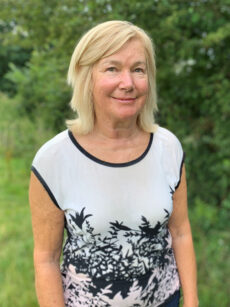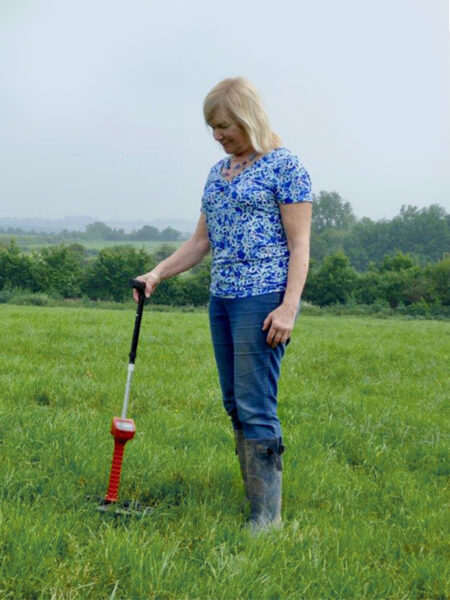Working in partnership, Rosemary and Joe Collingborn run a carefully bred, closed herd of 130 pedigree Friesen cows at Hill End Farm near Chippenham. Their 68ha farm is ecologically managed to create harmony between commercial production and conservation. “We have purposefully bred a cow that thrives on a grass-based system and produces a good yield with excellent quality from forage,” says Mrs Collingborn.
The cows are rotationally grazed on permanent pasture and long-term leys – producing an average lactation of 7,625 litres, with butterfat and protein at 4.3% and 3.3%, respectively. Around half of the milk is produced from forage.

Rosemary Collingborn is a passionate advocate of British dairy farming.
Sequestering carbon with soil
For over 30 years the Collingborns have farmed sympathetically to the environment and soil carbon; including planting 1,400 trees, maintaining permanent pasture and reducing soil disturbance.
“The dairy sector and grass-based systems are receiving a lot of flak over their carbon emissions,” says Mrs Collingborn, who finds such misinformation very frustrating. “I don’t understand how they have got it so wrong. Livestock farming – like dairying on a grassland farm – is a very effective way of producing food in a way which benefits the environment and has the potential to sequester carbon.”
Working with Kingshay
So after reading Kingshay’s work on SOC, she contacted her local water company – Wessex Water – to help work on the project with them. “Wessex Water were very interested and agreed, and Kingshay started analysing the samples in August this year,” she says.
“I thought it would be a very effective way of producing the evidence that dispels myths and backs up the positive message that grass-based systems are key for carbon sequestration and climate change mitigation.”
Livestock farming is a very effective way of producing food in a way which benefits the environment and has the potential to sequester carbon.
Rosemary Collingborn
Evaluation of the soil samples
Soil samples from a third of the farm were sent for CarbonCheck analysis and textural classification. Clay content ranged from 48% to 61% and the SOC content followed the clay, ranging from 6.7% to 8.8%.
From this the SOC/clay ratio was calculated, yielding a positive reflection of the couple’s grassland management, ranging from 0.121 to 0.16. All fields bar one were category indexed as very good; achieving a SOC/clay ratio greater than 0.125 – but the lower performing field still indexed as good (> 0.1 but <0.125).
The team then benchmarked Hill End Farm against the 100 UK farms sampled under the Kingshay SOC project; 85% of its samples were very good, compared to the survey average of 50%.

The Collingborns want to create harmony between commercial production and conservation.
Based on the farm’s soil bulk density – and with zero stones in the top 15cm profile – they calculated its carbon stocks to average 91.14t/ha, with a range from 79.4t/ha to 99t/ha. That’s well above the UK average of 61t/ha.
Using the knowledge about the soil
So how can the Collingborns use the analysis report? “The analysis has given us a much greater awareness of our soils and their ability to sequester and retain carbon,” says Mrs Collingborn. “We can use what we know to make informed decisions. “And crucially, it backs up the message that managed grassland is very important in combatting climate change.”

The Collingborns have recently introduced plate metering to better manage the grazing platform, maximise forage and minimise soil damage.
The report advised two main actions to help reduce carbon losses: Minimise soil disturbance and avoid soil degradation.
The Collingborns have already minimised field operations when reseeding by using minimum tillage. And they have stitched in white clover to silage leys to help fix nitrogen and increase the C:N ratio – bolstering soil carbon retention.
Maximise forage, minimise soil damage
For the past 20 years they have rotationally grazed their cows –and have recently introduced plate metering to better manage the grazing platform, maximise forage and minimise soil damage. “Cows are grazed for one to two days and then moved on – they go in with the grass at 2,800kg DM/ha and are moved out at 1,600kg DM/ha – and fields are rested for 21 days,” explains Mrs Collingborn.
The farm also composts its farmyard manure to maximise nutrient value and availability, and maintain or build SOM and SOC levels, with soil testing every three to five years. “Testing is very worthwhile – but it isn’t without cost. Our milk processor is looking at carbon testing and it could be something it funds in the future – it would be great if processors assisted with these costs as it could be very beneficial for them as well as the farmer.”
